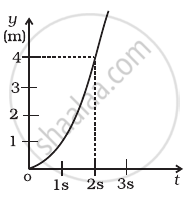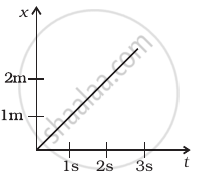Advertisements
Advertisements
Question
A stone is thrown vertically upward with a velocity of 9.8 m/s. When will it reach the ground?
Solution
Initial speed of ball is = 9.8 ms-1.
Acceleration due to gravity = -9.8 ms-2.
Final speed at maximum height = 0 ms-1.
We know v = u + at
0 = 9.8 - 9.8 t
T = 1 sec.
We know v2 - u2 =2as
At highest point final velocity is zero so
0 - 9.8 X 9.8 = 2 X (-9.8) S
S = 4.9 m.
for highest point initial velocity is zero
Acceleration due to gravity is = 9.8 ms-2.
Final velocity at ground is v
V2 - 0 = 2 X9.8 X 4.9
V = 9.8 ms-1.
Time taken to reach ground from highest point
V = u + at
9.8 = 0 + 9.8 t
T = 9.8/9.8 = 1 sec.
Total time = time of ascent + time of descent.
Total of flight = 1+ 1 = 2 seconds.
APPEARS IN
RELATED QUESTIONS
A rocket with a lift-off mass 20,000 kg is blasted upwards with an initial acceleration of 5.0 m s–2. Calculate the initial thrust (force) of the blast.
Explain why a cricketer moves his hands backwards while holding a catch.
An aircraft executes a horizontal loop at a speed of 720 km/h with its wings banked at 15°. What is the radius of the loop?
Suppose the ceiling in the previous problem is that of an elevator which is going up with an acceleration of 2.0 m/s2. Find the elongation.
Consider the Atwood machine of the previous problem. The larger mass is stopped for a moment, 2.0 s after the system is set into motion. Find the time that elapses before the string is tight again.
Use Newton's second law of motion to explain the following instance :
An athlete prefers to land on sand instead of hard floor while taking a high jump .
The correct form of Newton's second law is :
What causes motion in a body?
Use Newton's second law to explain the following:
We always prefer to land on sand instead of hard floor while taking a high jump.
Figure shows (x, t), (y, t ) diagram of a particle moving in 2-dimensions.
|
|
 (b) |
If the particle has a mass of 500 g, find the force (direction and magnitude) acting on the particle.

